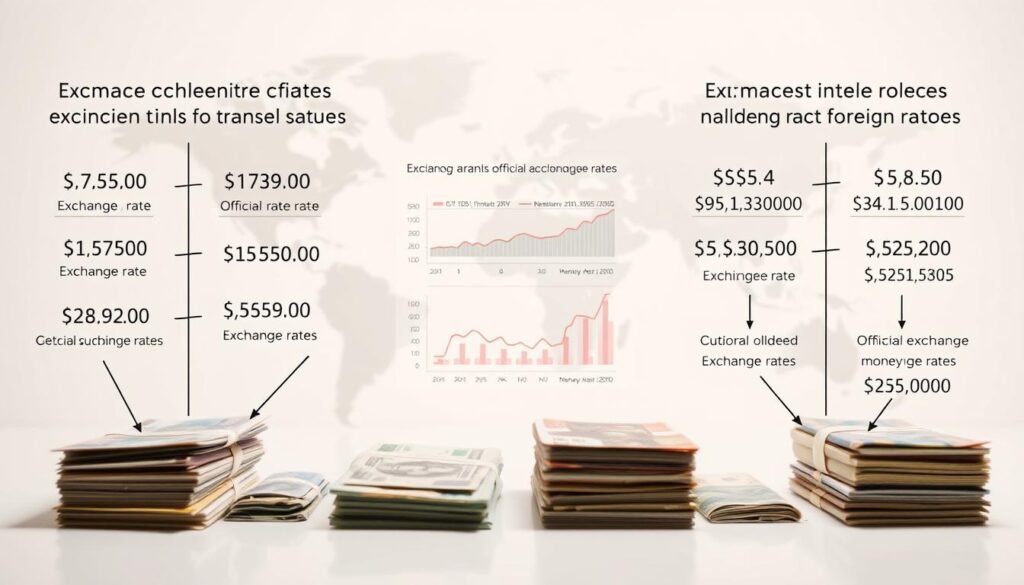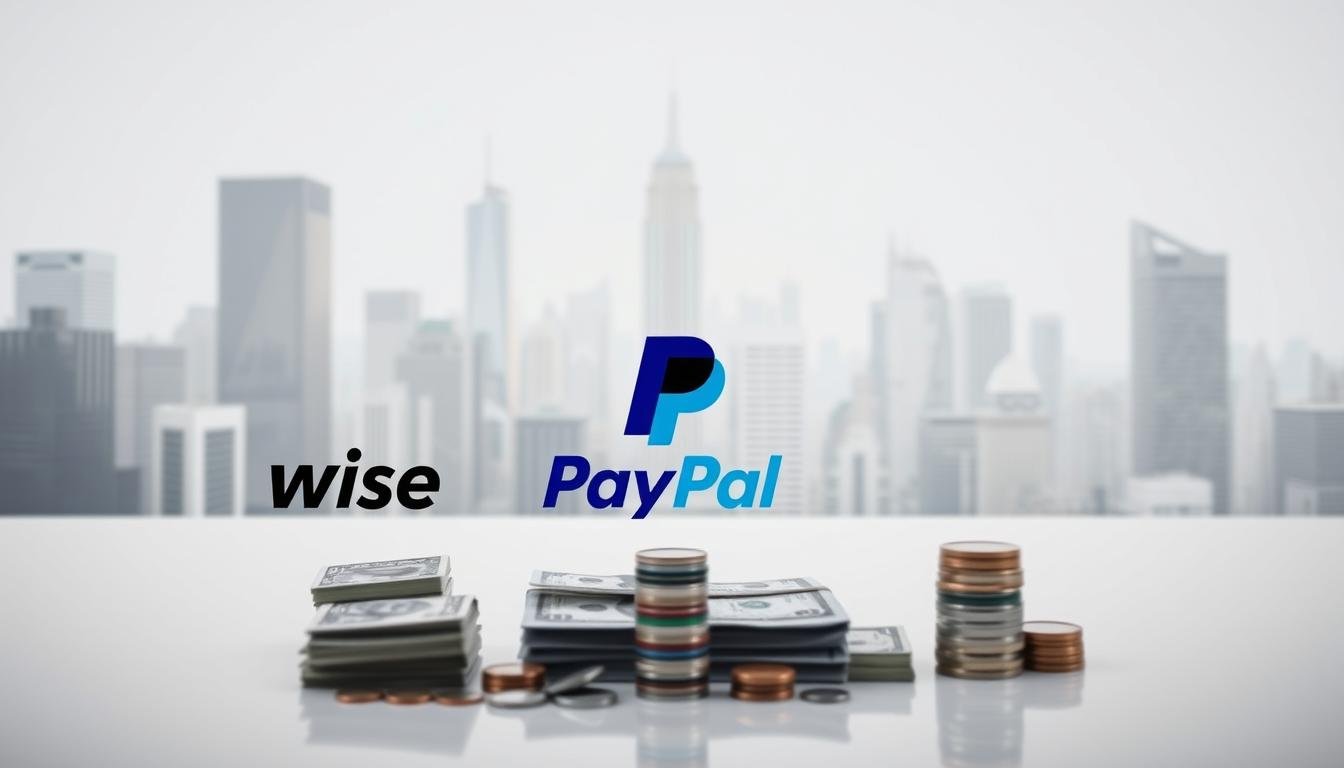Americans lose over $4 billion annually to unexpected charges when sending money overseas. These sneaky costs often triple the actual expense of your transfer. Most people discover these hidden fees only after completing their transaction.
Sending money internationally shouldn’t drain your wallet through deceptive practices. Whether you’re supporting family abroad or paying for services, understanding how to avoid hidden fees in international money transfers can save you hundreds each year.
Traditional banks often charge markup rates of 3-5% above market rates. Services like Wise typically offer more transparent pricing with lower overall costs. The difference can be substantial for regular senders.
This guide reveals the most effective cross-border money transfer tips to protect your hard-earned money. You’ll learn to identify deceptive charges, compare true costs between providers, and secure better exchange rates for your overseas transactions.
Understanding the True Cost of International Money Transfers
When you send money abroad, the advertised transfer fee represents only a fraction of what you’ll actually pay. International wire transfer costs include multiple components that providers often present separately or hide entirely. This fragmented approach makes it nearly impossible to compare services accurately.
Most banks and transfer services display their fees in a way that obscures the total expense. They’ll show you the transfer fee prominently while burying exchange rate markups and additional charges in fine print. The result? Your $1,000 transfer might only deliver $940 to your recipient.
Understanding foreign currency transfer expenses requires examining every fee component. The true cost calculation involves adding the stated transfer fee, exchange rate differences, and any intermediary charges. This comprehensive approach reveals the actual amount you’ll pay.
The variation in total costs between providers can be dramatic. Some services charge as little as 0.5% of your transfer amount. Others may take 4-6% or more through various fee structures. This difference can mean hundreds of dollars on larger transfers.
| Cost Component | Typical Range | Impact on $1,000 Transfer | Visibility Level |
|---|---|---|---|
| Transfer Fee | $15-$50 | $15-$50 | Clearly Displayed |
| Exchange Rate Markup | 1-4% | $10-$40 | Often Hidden |
| Intermediary Bank Charges | $10-$25 | $10-$25 | Rarely Disclosed |
| Receiving Bank Fees | $5-$20 | $5-$20 | Usually Hidden |
Learning to calculate total costs upfront protects you from surprise charges. Foreign currency transfer expenses become predictable when you know what to look for. This knowledge empowers you to make informed comparisons and choose the most cost-effective option.
The key is demanding transparency from your transfer provider. Ask for a complete breakdown of all fees before committing to any international money transfer. Your wallet will thank you for this extra diligence.
Common Hidden Fees That Drain Your Transfer Value
Several types of hidden charges work together to drain value from your international money transfers without clear disclosure. These fees often appear in different forms throughout the transfer process. Understanding each type helps you calculate the real cost before sending money abroad.
Transfer providers use various methods to generate revenue beyond their advertised fees. Many customers focus only on the upfront transfer fee while missing other significant costs. The total impact of these hidden charges can add hundreds of dollars to large transfers.
Exchange Rate Markups and Spreads
Foreign exchange markup fees represent the most common and costly hidden charge in international transfers. Providers offer exchange rates that are significantly worse than the mid-market rate. This markup essentially builds their profit directly into the currency conversion process.
These markups typically range from 2-4% above the real exchange rate. A $5,000 transfer could cost you an extra $100-200 without obvious disclosure. Many providers advertise “no fees” while hiding substantial profits in poor exchange rates.
The spread between the mid-market rate and the offered rate varies by provider and currency pair. Major currencies like EUR/USD typically have smaller spreads than exotic currency pairs. Always compare the offered rate against current mid-market rates before confirming your transfer.
Intermediary Bank Charges
Intermediary bank charges occur when your transfer passes through multiple financial institutions before reaching its destination. Each bank in the chain takes a processing fee along the way. These fees are often unpredictable and vary by routing path.
Remittance service charges from intermediary banks can range from $15-50 per institution involved. The number of intermediary banks depends on the currency corridor and banking relationships. Some transfers may pass through 2-3 different banks before completion.
SWIFT network transfers are particularly susceptible to these charges. Alternative payment networks often reduce or eliminate intermediary bank involvement. Ask your provider about their routing methods to understand potential intermediary costs.
Receiving Bank Processing Fees
Receiving bank processing fees are charged directly to your recipient when they collect the transferred funds. These fees effectively reduce the amount your recipient receives. The charges vary significantly between different banks and countries.
Processing fees typically range from $10-30 per incoming transfer. Some banks charge a percentage of the transfer amount instead of a flat fee. Recipients often discover these charges only when collecting their funds at the destination bank.
Correspondent Bank Fees
Correspondent bank fees add another layer of cost when banks use partner institutions in foreign countries to complete transfers. These partnerships are necessary for banks without direct presence in destination countries. Each correspondent relationship involves additional processing charges.
These fees often result in unexpected deductions from your transfer amount. The charges appear as separate line items on transfer receipts. Correspondent bank fees can add $25-75 to your total transfer cost depending on the banking network used.
Understanding these various fee types helps you ask the right questions when comparing providers. Calculate the true cost of your international money transfer by accounting for all potential charges. This comprehensive approach ensures you choose the most cost-effective option for your specific transfer needs.
How Traditional Banks Hide Their International Transfer Costs
Major financial institutions employ sophisticated methods to obscure the true cost of international money transfers. These practices have evolved over decades, creating a maze of fees that even experienced customers struggle to navigate.
Banks excel at burying international banking surcharges deep within lengthy terms and conditions documents. Most customers never read these dense legal texts, which can span dozens of pages. The most significant fees often appear in small print or technical language that obscures their real impact on your transfer.
The most deceptive practice involves advertising “low” or “free” transfer fees while applying massive exchange rate markups. Banks promote competitive rates without revealing that their exchange rates can be 3-5% worse than the mid-market rate. For a $10,000 transfer, this hidden markup can cost you $300-500 more than advertised.
Intermediary bank charges represent another layer of global remittance hidden costs. Your sending bank may claim they have no control over these “lifting fees,” but they rarely disclose them upfront. These charges can range from $15-50 per transfer, depending on the currency corridor and banking relationships.
“Banks have perfected the art of fee obfuscation, making it nearly impossible for consumers to compare true transfer costs across different providers.”
Many banks also fail to communicate that recipients face additional charges from their local banks. These receiving fees can reduce the final amount by $10-25, creating surprise deductions that weren’t part of the original cost calculation.
The table below reveals common bank fee hiding tactics:
| Hiding Method | How It Works | Typical Cost Impact | Disclosure Level |
|---|---|---|---|
| Exchange Rate Markup | Advertise “competitive rates” while marking up 3-5% | $300-500 per $10,000 | Rarely disclosed |
| Intermediary Fees | Claim “no control” over correspondent bank charges | $15-50 per transfer | Mentioned in fine print |
| Receiving Bank Charges | Don’t inform about recipient-side deductions | $10-25 reduction | Not disclosed |
| Weekend/Holiday Rates | Apply worse rates during off-hours | Additional 0.5-1% markup | Buried in terms |
Banks use phrases like “competitive exchange rates” and “transparent pricing” in their marketing materials. However, these terms have no standardized meaning in the banking industry. What banks consider “competitive” may still cost significantly more than specialized transfer services.
This deliberate lack of transparency serves bank profit margins while leaving customers financially disadvantaged. Understanding these deceptive practices becomes crucial for anyone who regularly sends money internationally and wants to avoid unnecessary costs.
Wise Fees vs Bank Transfer Fees: Complete Cost Breakdown
The fee structure comparison between Wise and banks shows dramatic differences in how overseas money transfer commissions are calculated. While both options move your money internationally, their pricing models couldn’t be more different.
Traditional banks often advertise low transfer fees but make their real profit through hidden markups. Wise takes the opposite approach with transparent pricing that shows you exactly what you’ll pay upfront.
Traditional Bank Fee Structure Analysis
Most major banks charge a flat wire transfer fee between $15 and $50 for international transfers. However, this advertised fee represents only a fraction of your total cost.
The real expense comes from exchange rate markups ranging from 2% to 4% above the mid-market rate. Banks also add intermediary fees when your transfer passes through correspondent banks.
These additional charges can include receiving bank fees, processing fees, and currency conversion costs. The result is a transfer that appears to cost $25 but actually costs $60 or more.
Wise Transparent Fee Model
Wise operates on a completely different pricing structure that eliminates hidden costs. They charge a small percentage-based fee, typically 0.5% to 1% depending on the currency pair, plus a minimal fixed fee.
The key difference is that Wise uses the real mid-market exchange rate with no markup whatsoever. This means you get the same rate you see on Google or financial news sites.
All fees are calculated and displayed upfront before you confirm your transfer. There are no surprise deductions or additional charges along the way.
Side-by-Side Cost Comparison Examples
Real-world examples demonstrate the significant savings possible with transparent fee structures. These comparisons use actual rates and fees from major US banks versus Wise.
$1,000 Transfer Cost Analysis
A typical $1,000 transfer from the US to the UK through a major bank might cost:
- Wire transfer fee: $25
- Exchange rate markup: $35 (3.5% markup)
- Total cost: $60
The same transfer through Wise would cost approximately $8 to $12 total, representing savings of over 80%.
$5,000 Transfer Cost Analysis
For larger amounts, the savings become even more dramatic. A $5,000 bank transfer typically costs:
- Wire transfer fee: $45
- Exchange rate markup: $175 (3.5% markup)
- Intermediary fees: $30
- Total cost: $250
Wise would charge approximately $35 to $50 for the same transfer, saving you over $200. These examples show why understanding true transfer costs matters more than focusing solely on advertised fees.
How to Avoid Hidden Fees in International Money Transfers
Protecting yourself from unexpected cross-border payment fees starts with understanding exactly what you’ll pay before hitting send. Many people discover costly surprises only after their transfer is complete. Taking a proactive approach saves both money and frustration.
The foundation of smart international transfers lies in thorough preparation. You need to become a detective, uncovering every potential charge that could affect your transfer. This systematic approach protects you from the shock of discovering your $1,000 transfer actually cost $1,150.
Research All Fee Components Before Sending
Start your research by requesting a complete breakdown of all potential charges from each provider you’re considering. Don’t accept vague answers or marketing speak. You need specific numbers for transfer fees, exchange rate markups, intermediary bank charges, and recipient fees.
Create a simple checklist to ensure you’ve covered all bases. Ask about weekend processing fees, rush transfer charges, and any additional costs for specific destination countries. Some providers charge extra for transfers to certain regions or during peak times.
Cross-border payment fees can include surprising elements like correspondent bank charges that only appear when your money passes through multiple financial institutions. These intermediary costs often remain hidden until after you’ve initiated the transfer.
“The biggest mistake people make is focusing only on the advertised transfer fee while ignoring the exchange rate markup, which can cost significantly more than the upfront fee.”
Document everything in writing or via email. This creates a paper trail you can reference if unexpected charges appear later. Reputable providers will gladly provide detailed fee breakdowns in advance.
Compare Total Transfer Costs, Not Just Advertised Rates
Advertised rates tell only part of the story. A provider advertising “no fees” might offer terrible exchange rates that cost you more than a competitor with transparent fees but better rates. Always calculate the total cost of your transfer.
Use the mid-market exchange rate as your baseline for comparison. Check current rates on XE.com or Google, then compare what each provider offers. The difference between the mid-market rate and the provider’s rate represents hidden markup costs.
Create a comparison spreadsheet for your typical transfer amount. Include all fees, exchange rate differences, and delivery timeframes. This visual comparison reveals which providers offer genuine value versus those with misleading marketing.
| Provider Type | Advertised Fee | Exchange Rate Markup | Hidden Charges | Total Cost ($1,000 transfer) |
|---|---|---|---|---|
| Traditional Bank | $25 | 3-4% | $15-30 | $70-85 |
| Online Platform | $5-15 | 0.5-1% | $0-10 | $15-35 |
| Digital Service | $0-8 | 0.3-0.8% | $0-5 | $8-25 |
| Cryptocurrency | $2-10 | 0.1-0.5% | $5-15 | $12-30 |
Remember that international transfer costs can vary significantly based on destination country, transfer amount, and payment method. A provider that’s cheapest for one route might be expensive for another.
Choose Providers with Fee Transparency
Transparency separates trustworthy providers from those hiding costs in fine print. Look for companies that display all fees clearly on their websites, including real-time exchange rates and fee calculators. These tools let you see exactly what you’ll pay before committing.
Avoid providers using vague language like “competitive rates” or “low fees” without specific numbers. Legitimate money transfer services proudly display their pricing structure because they know it’s competitive.
Read recent customer reviews focusing specifically on fee-related complaints. These reviews often reveal hidden charges that don’t appear in marketing materials. Pay attention to complaints about surprise fees, poor exchange rates, or costs that appeared after the transfer started.
Test the provider’s customer service by asking detailed questions about their fee structure. Responsive, knowledgeable support staff indicate a company that stands behind its pricing. If representatives can’t clearly explain all potential costs, consider it a red flag.
Choose services that send detailed receipts showing exactly how your money was converted and what fees were applied. This documentation helps you verify you received the promised rate and can serve as evidence if disputes arise.
By following these systematic steps, you’ll identify truly cost-effective transfer options and avoid the unpleasant surprise of discovering your transfer cost significantly more than expected. Smart preparation is your best defense against hidden fees in international money transfers.
Reading Transfer Agreements: Spotting Hidden Charges
The devil is in the details when it comes to international money transfer agreements, where providers legally bury costly fees in confusing language. These documents serve as the official disclosure of all charges, but they’re written to protect the company rather than help you understand costs.
When reviewing transfer agreements, focus on specific sections that reveal true expenses. Look for headings labeled “Fees,” “Exchange Rates,” “Third-Party Charges,” and “Intermediary Bank Fees.” These sections contain the most important information about what you’ll actually pay.

Watch for red flag phrases that signal hidden costs ahead. Terms like “plus applicable exchange rate margin” or “subject to correspondent bank charges” indicate additional fees beyond the advertised rate. The phrase “recipient may incur additional fees” means your recipient could face unexpected deductions.
International wire transfer costs often appear in multiple categories within these agreements. You’ll find origination fees, processing fees, and conversion charges that marketing materials rarely mention clearly. These separate line items can add up to significant amounts.
“Many agreements contain language about ‘lifting fees’ or ‘intermediary charges’ that can be deducted from your transfer amount without prior notification.”
Pay special attention to clauses about fee changes. Some providers reserve the right to modify charges without notice. Others disclaim responsibility for fees imposed by other banks in the transfer chain, leaving you vulnerable to surprise deductions.
Create a systematic approach to reviewing these documents. Make a checklist of unclear terms and contact customer service for explanations. Don’t hesitate to ask specific questions about international wire transfer costs and how they’re calculated.
- Request examples of total costs for your transfer amount
- Ask about all possible third-party charges
- Confirm what your recipient will actually receive
- Get written confirmation of the final exchange rate
Never proceed with a transfer until you fully understand every fee component. If a provider can’t clearly explain their charges, consider that a warning sign to look elsewhere for your international money transfer needs.
Best Low-Fee Alternatives to Traditional Bank Transfers
Today’s consumers have access to revolutionary financial technologies that make international money transfers faster, cheaper, and more transparent than ever before. These innovative solutions offer significant savings compared to traditional banking methods. Each alternative provides unique benefits for different transfer needs and preferences.
Online Money Transfer Platforms
Specialized online platforms like Wise, Remitly, and WorldRemit have revolutionized international transfers. These services operate with lower overhead costs than traditional banks. They offer transparent fee structures and real-time exchange rates.
Most platforms provide clear fee breakdowns before you send money. Transfer times are typically faster than bank wire transfers. Many users save 60-80% on fees compared to traditional banking options.
Digital Payment Services
Popular services like PayPal, Skrill, and Payoneer offer convenient international transfer options. However, remittance service charges can vary significantly based on funding sources. Credit card funding typically costs more than bank account transfers.
These platforms often include buyer protection features. They integrate well with e-commerce activities. Transfer speeds are usually faster than traditional methods, though fees may be higher than specialized platforms.
Cryptocurrency-Based Transfer Options
Digital currency solutions represent the newest frontier in money transfers. Stellar, Ripple-based platforms, and Bitcoin remittance services can complete transfers in minutes. Fees often stay under 1% of the transfer amount.
Both sender and recipient need comfort with digital currencies. Regulatory considerations vary by country. These options work best for tech-savvy users who prioritize speed and low costs over traditional banking convenience.
Strategic Timing to Minimize Transfer Costs
Currency markets never sleep, but knowing when they’re most active can slash your transfer expenses. Exchange rates fluctuate constantly throughout the day, creating windows of opportunity for savvy senders who understand market patterns.
The best transfer rates typically emerge during overlapping business hours of major financial centers. When London, New York, and Tokyo markets operate simultaneously, increased liquidity often leads to tighter spreads and better deals.
Foreign exchange markup fees can vary significantly based on market conditions. Many providers offer better rates during high-volume trading periods when competition intensifies among financial institutions.
Smart senders use rate alerts through transfer platforms or financial apps. These tools notify you when your desired exchange rate becomes available, allowing you to time transfers for maximum value.
Consider forward contracts or rate locks for future transfers. These tools protect you from adverse rate movements by securing favorable exchange rates in advance.
Avoid transferring money during major economic announcements, political events, or market holidays. During these periods, spreads typically widen and foreign exchange markup fees may increase substantially.
For regular transfers, establish a schedule based on historical rate patterns for your specific currency pair. Always compare rates across multiple providers before executing time-sensitive transfers to ensure optimal deals.
Decoding Exchange Rate Tricks and Markups
Most people never realize how exchange rate markups silently drain their international transfer value. These hidden charges represent one of the most profitable revenue streams for money transfer providers. While advertised fees might seem reasonable, the real cost often lies buried within manipulated exchange rates.
Exchange rate manipulation allows providers to maintain competitive appearances while secretly inflating foreign currency transfer expenses. This practice affects millions of transfers daily. Understanding these tactics helps you protect your money from unnecessary losses.

Understanding Mid-Market Rates
The mid-market rate serves as your benchmark for measuring true exchange rate value. Also called the interbank rate, this represents the real-time value between two currencies. Banks use this rate when trading with each other, making it the fairest possible exchange rate.
You can find mid-market rates on financial websites like XE.com or Google Finance. These platforms show the actual market value without any provider markups. This rate changes constantly throughout the day based on global market conditions.
Most providers never offer the true mid-market rate to consumers. Instead, they add their own markup to generate profit. The difference between their rate and the mid-market rate reveals exactly how much extra you’re paying in foreign currency transfer expenses.
Calculating Real Exchange Rate Costs
Calculating your real exchange rate costs requires simple math but reveals shocking truths. Start by finding the current mid-market rate for your currency pair. Then compare it against your provider’s offered rate to see the markup percentage.
Here’s the calculation process:
- Find the mid-market rate (example: 1.2500 USD/EUR)
- Check your provider’s rate (example: 1.2100 USD/EUR)
- Calculate the difference (0.0400)
- Divide by the mid-market rate (0.0400 ÷ 1.2500 = 0.032 or 3.2%)
This 3.2% markup applies to your entire transfer amount. On a $5,000 transfer, you’d pay an extra $160 in hidden foreign currency transfer expenses. These costs add up quickly, especially for regular senders.
Many providers use psychological tricks to hide these markups. They display rates with excessive decimal places or use confusing currency presentations. Always convert their rates to a standard format for accurate comparison.
Using Rate Comparison Tools
Rate comparison tools simplify the process of finding fair exchange rates. Websites like XE.com, Google Finance, and specialized transfer comparison platforms show real-time mid-market rates. These tools help you quickly identify which providers offer rates closest to the true market value.
Some comparison websites also calculate total transfer costs automatically. They factor in both fees and exchange rate markups to show your real foreign currency transfer expenses. This comprehensive view helps you make informed decisions.
Professional comparison tools often update rates every few minutes. This real-time data ensures you’re working with current information. Bookmark these resources and check them before every international transfer.
Understanding exchange rate manipulation empowers you to negotiate better deals with providers. You can also switch to more transparent alternatives that don’t rely on hidden exchange rate profits. Knowledge of these tactics transforms you from an easy target into an informed consumer who protects their money effectively.
Warning Signs of Excessive International Transfer Fees
Warning signs of overpriced transfer services are easier to detect when you know what to look for. Being alert to these red flags can save you from costly mistakes and help you avoid predatory providers.
The biggest warning sign is when providers refuse to give you clear, upfront pricing. Legitimate services should always provide transparent fee breakdowns before you commit to anything. If a company won’t show you their exchange rates, transfer fees, or potential third-party charges, walk away immediately.
Be suspicious of international banking surcharges that seem unusually high compared to competitors. When fees are presented as “estimates” rather than fixed amounts, this often signals poor transparency and reliability.
Watch out for providers advertising “free” transfers while offering terrible exchange rates. This classic trick hides their profits in currency conversion rather than transparent fees. The mid-market rate should be your benchmark for comparison.
Other major red flags include:
- Requiring account creation before showing rates and fees
- Using high-pressure sales tactics or urgency claims
- Failing to provide proper regulatory licensing information
- Unclear or confusing fee structure explanations
Be cautious of services that don’t offer customer support in your language. Proper dispute resolution processes are essential if problems arise with your transfer.
A reputable money transfer provider should be completely transparent about all costs upfront, without requiring you to jump through hoops to get basic pricing information.
Trust your instincts when something feels off. If a provider seems evasive about costs or pressures you to act quickly, those are clear signs to look elsewhere for your international transfer needs.
Smart Strategies for Frequent International Senders
Frequent international transfers create unique opportunities to slash costs through smart scheduling and relationship building with providers. Regular senders can leverage their transfer volume to negotiate better rates and access exclusive benefits that one-time users never see. The key lies in treating your international transfers as a strategic financial activity rather than isolated transactions.
Understanding your transfer patterns opens doors to significant savings. Most frequent senders can reduce their global remittance hidden costs by 30-50% through proper planning and provider relationships. This approach requires analyzing your sending habits and building long-term strategies around them.
Setting Up Cost-Effective Transfer Schedules
Timing your transfers strategically can dramatically reduce your overall costs. Instead of sending money whenever the need arises, consider batching smaller amounts into larger, less frequent transfers. This approach takes advantage of fixed-fee structures that many providers use.
Many transfer services charge a flat fee regardless of the amount sent. Sending $500 five times costs more in fees than sending $2,500 once. Consolidating transfers can cut your fee burden significantly while maintaining the same total amount sent to recipients.
Weekly or bi-weekly transfer schedules work well for most frequent senders. This timing allows you to accumulate funds while still providing regular support to recipients. Some providers offer scheduled transfer discounts for customers who set up recurring payments.
Consider your recipient’s needs when planning schedules. Emergency situations may require immediate transfers, but regular support payments can follow a more cost-effective timeline. Building a small buffer with recipients helps accommodate this scheduling approach.
Utilizing Multi-Currency Account Benefits
Multi-currency accounts represent one of the most powerful tools for frequent international senders. These accounts allow you to hold funds in multiple currencies simultaneously, eliminating the need for immediate conversion with each transfer.
Providers like Wise, Revolut, and several traditional banks offer multi-currency account options. These accounts typically provide better exchange rates and lower fees compared to single-transaction conversions. Account holders often receive preferential treatment and reduced fees.
The timing advantage of multi-currency accounts cannot be overstated. You can convert funds when exchange rates are favorable rather than when you need to send money. This flexibility can result in significant savings over time, especially for large or frequent transfers.
Multi-currency accounts also reduce overseas money transfer commissions by eliminating repeated conversion fees. Instead of converting USD to EUR for each transfer, you can convert larger amounts when rates are good and send from your EUR balance as needed.
| Account Type | Monthly Fee | Conversion Rate | Transfer Fee | Best For |
|---|---|---|---|---|
| Wise Multi-Currency | $0 | Mid-market rate | 0.5-2% | Regular transfers under $10K |
| Revolut Premium | $9.99 | Interbank rate | Free up to $1K/month | Frequent small transfers |
| HSBC Global Account | $25 | Bank rate + 2-4% | $15-45 | High-volume business transfers |
| Citibank Global Transfers | $30 | Bank rate + 3-5% | $25-50 | Large personal transfers |
Negotiating Better Rates for High-Volume Transfers
High-volume senders possess significant negotiating power that most never utilize. Transfer providers compete aggressively for customers who send large amounts or make frequent transfers. Don’t hesitate to contact customer service to discuss volume discounts and preferential rates.
Document your transfer history before negotiating. Providers want to see consistent volume and frequency. Customers who send $5,000+ monthly or make 10+ transfers per month typically qualify for negotiated rates. Some providers offer business account rates to high-volume personal customers.
Consider establishing relationships with multiple providers to leverage competitive rates. Different providers may offer better rates for specific currency pairs or transfer corridors. Having options allows you to choose the most cost-effective service for each transfer.
Volume discounts often reduce both overseas money transfer commissions and exchange rate markups. Some providers eliminate transfer fees entirely for high-volume customers while offering mid-market exchange rates. These benefits can result in thousands of dollars in annual savings.
Maintain detailed records of your transfer costs to identify trends and opportunities. Track total fees, exchange rate costs, and transfer times across different providers. This data becomes valuable when negotiating with providers or deciding whether to switch services.
Regular review of your transfer costs ensures you’re getting the best available rates. Provider fee structures change frequently, and new competitors enter the market regularly. Annual cost reviews help frequent senders stay ahead of market changes and maintain optimal transfer strategies.
Building long-term relationships with transfer providers often leads to additional benefits beyond cost savings. Priority customer service, faster transfer processing, and advance notice of rate changes are common perks for valued customers. These relationships can prove invaluable when you need urgent transfers or encounter transfer issues.
Protecting Yourself from Surprise Charges and Fee Changes
Preventing surprise charges in cross-border payments requires consistent vigilance and smart documentation practices. Your first line of defense involves maintaining detailed records of every transaction you make. Save all confirmation emails, receipts, and transaction records that clearly show the fees you agreed to pay.
These documents serve as crucial proof if disputes arise about unexpected charges. Many consumers overlook this simple step, but proper documentation can save you hundreds of dollars in disputed fees. Store these records in both digital and physical formats for easy access.
Cross-border payment fees can change without notice with some providers, making regular monitoring essential. Review the terms and conditions of services you use frequently, especially before making large transfers. Sign up for notifications about policy changes when available through your provider’s website or mobile app.
Set up account alerts that inform you of changes to fee structures, exchange rates, or terms of service. Most reputable providers offer email or SMS notifications for policy updates. Enable these alerts immediately after opening your account to stay informed about any modifications.
If you discover unexpected charges on your account, contact customer service immediately with your documentation. Many providers will reverse fees that weren’t properly disclosed, especially when you have written proof of the original agreement. Be persistent but polite when disputing charges.
Consider using providers that offer fee guarantees or price protection policies. These services lock in your costs at the time of transfer initiation, protecting you from sudden rate changes. While not all providers offer this feature, it’s worth seeking out for regular transfers.
For significant transfers, always request written confirmation of all fees and exchange rates before proceeding. Don’t hesitate to cancel a transfer if the final costs differ from what was initially quoted. Your money, your choice – never feel pressured to complete a transaction with unexpected fees.
| Protection Strategy | Implementation | Benefit | Time Investment |
|---|---|---|---|
| Document Everything | Save all receipts and confirmations | Dispute protection | 2 minutes per transfer |
| Monitor Terms Changes | Review provider policies monthly | Avoid surprise fees | 15 minutes monthly |
| Set Up Alerts | Enable notifications in account settings | Real-time updates | 5 minutes setup |
| Request Written Quotes | Get fee confirmation before large transfers | Cost certainty | 3 minutes per transfer |
Familiarize yourself with consumer protection regulations in your country regarding financial services. These regulations may provide recourse if you encounter deceptive fee practices or unauthorized charges. The Consumer Financial Protection Bureau offers resources for understanding your rights in financial transactions.
Remember that prevention is always better than cure when it comes to unexpected fees. By staying informed, documenting everything, and choosing transparent providers, you can avoid most surprise charges in international money transfers.
Conclusion
Learning how to avoid hidden fees in international money transfers puts real money back in your pocket. The strategies covered in this guide give you the tools to spot sneaky charges before they drain your transfer value. Research providers carefully, compare total costs instead of just advertised rates, and choose services that show you exactly what you pay.
Your transfer habits can save you hundreds of dollars each year. Time your transfers when exchange rates work in your favor. Build relationships with transparent providers who offer better deals for regular customers. Keep detailed records of your transactions to track your savings and spot new opportunities.
The money transfer industry keeps changing with new technologies and increased competition. This creates better options for smart consumers who know how to avoid hidden fees in international money transfers. Stay informed about new services, review your transfer costs regularly, and switch providers when you find better deals. Your diligence in comparing options and understanding true costs will protect your hard-earned money for years to come.







Leave a Reply